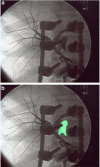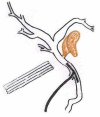Isolated extrahepatic bile duct rupture: a rare consequence of blunt abdominal trauma. Case report and review of the literature
- PMID: 22624830
- PMCID: PMC3470986
- DOI: 10.1186/1749-7922-7-16
Isolated extrahepatic bile duct rupture: a rare consequence of blunt abdominal trauma. Case report and review of the literature
Abstract
A 16-year-old girl suffered blunt abdominal trauma. Clinically, a severe motor impairment with paraesthesia of the legs was found. Posterior osteosynthesis in T10-L1 with laminectomy in T10-T12 and posterolateral arthrodesis in T11-T12 was performed because of a dorsal traumatic vertebral fracture. On hospital day 7, because of an acute abdomen, surgical laparoscopic exploration showed sterile bloody fluid without any evident hemorrhagic injury. On hospital day 11, the patient was reoperated on by the laparoscopic approach for increasing abdominal pain and fever: a peritoneal biliary fluid was aspirated. After conversion to open surgery, cholecystectomy was performed. Intraoperative cholangiography was considered as normal. On arrival at our institution 13 days after injury, the patient was operated on for a biliary peritonitis. Intraoperatively, a trans-cystic cholangiography showed a biliary leakage of the common bile duct; a T-tube was placed into the common bile duct; a subhepatic drainage was placed too. On postoperative day 30, a T-tube cholangiography showed a normal biliary tree, without any leakage, and the T-tube was subsequently removed. The patient had a complete recovery.
Figures


References
-
- Simstein N. Isolated blunt trauma injury to the hepatic duct. Int Surg. 2000;85:55–56. - PubMed
LinkOut - more resources
Full Text Sources
Research Materials

